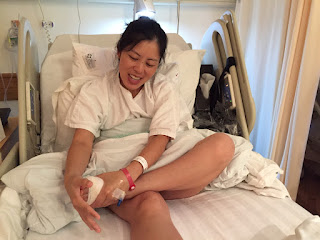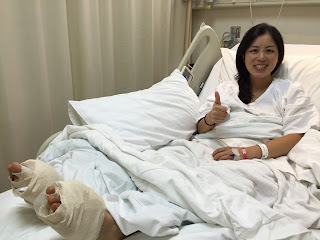Otherwise, I hobbled around the house okay, and spent most of my time keeping my feet elevated and continuing with my toe exercises. Keeping my feet elevated for the first week was important because it was uncomfortable when my feet were down and the blood was concentrating down to the bottom. With assistance, I was able to shower each day and we developed a good and efficient routine. Again, those foot covers are life savers! My pain level, at rest, was pretty much at zero after the 3rd day. I never had to take any pain medication after the 2nd day, which was great! The only time I experienced some pain was when I performed my toe exercises and was stretching the muscles/ligaments. This was to be expected and my right foot was a little more painful, whereas my left foot had no pain. The swelling also was not as significant as I thought it would be. The picture below is so far the worse I've seen, with some bruising around the big toe areas. I checked in with Rachel and Dr. Wu and they said it was to be expected. Rachel had provided me with some bruise ointment to use 2-3X a day, as needed. I used the ointment just a few times throughout the whole week. Also used ice packs when needed.
At Day 10 (October 29th), I was finally able to leave the house - hooray!! I had a follow-up appointment with Dr. Wu. Getting out of the house was not too difficult. Again, I needed to walk slowly and luckily my uncle's place has an elevator. I felt bad taking so long to just even walk to the elevator, but I kept telling myself not to rush and that people can wait a little longer for me to get in.
When I got to Dr. Wu's office, I had to wait for a bit because we were early for our appointment. The secretary, Grace, was very courteous and led me to the sofa where she then placed a platform in front of me to help me elevate my feet. Once Rachel was ready for me, she called me into the room to take new X-rays. At the same time, she also gave me the X-rays that were taken intra-op (during surgery). I didn't have an electronic copy available of the intra-op X-rays, so I had to make do with taking a picture of them (sorry for the poor quality). The X-rays look great though! I've also put a picture of my feet "before surgery" to act as a little comparison.
After the X-rays, Rachel checked both my feet to see how far back I could bend them. My feet were registered to be 80 degrees on my right and 75 degrees on my left. They were a little tight in the morning, but I know I needed to keep exercising so I could get to 90 degrees for both. Rachel then went ahead to take off my bandages. Luckily, I didn't quite know what to expect so there was no anxiety. But this part was somewhat painful. Even though the cuts had mostly healed, they still stung when the bandages were quickly removed and alcohol wipes were used to clean them. I was sucking in my stomach a bit to help me cope with the pain. It wasn't a sharp pain, but a very sensitive feeling that was uncomfortable. Rachel then went ahead to cut and remove some of the stitches. Again, it was not a pleasant feeling, but luckily she is so good at doing this, she removed everything quite quickly to minimize the pain. After she finished cleaning, she placed some clean surgical tape on my cuts, asked me to place my feet back into my surgical boots and then walk to a different room.
Dr. Wu joined us not too long afterwards. He asked how I was doing and how the pain was. I told him I had no pain and had not used any pain medication since the 2nd day. He then proceeded with adding additional surgical tape to secure my feet. Then he started to create the synthetic forefoot cast around the mid-to-top section of my feet. It was fascinating how he created this cast and it was definitely different than the casts I was used to seeing. The picture below shows the finished product. The casts do eventually become a little tight over time, which can contribute to some additional swelling of the toes. But overall, the swelling is still not that bad.
Walking in these casts has proven to be more interesting as it is a hard cast and now my feet are somewhat elevated. It kind of feels like I'm walking in cycling clip-on shoes as a comparison. This cast helps keep my feet secure and helps to ensure that the straight alignment of the feet are maintained. Again, doctor's orders are to stay at home with feet elevated as much as possible. Dr. Wu said I could go out to eat, but it is important that I don't walk too much and use my crutches. Eventually, after 1-2 months, Dr. Wu will suggest for me to stand a little more to start re-building the strength in my feet muscles.
Before I completed my appointment, I went ahead to schedule my last appointment with Dr. Wu before I head back to the US on November 30th. At the next appointment, he will be providing me with additional instructions and exercises to use when I am back home.
My uncle treated us to a nice lunch afterwards in Repulse Bay. He said that since I've been couped up in the house these past 10 days, we should eat a nice, stress free lunch. The staff at this restaurant were wonderful and very accommodating. It was the perfect setting as there were few people eating and I could take my time hobbling around the restaurant. The food was great too. Below are pictures of the restaurant and outside, plus me trying to tackle the front stairs. Slow, but I made it down to the bottom successfully!

























